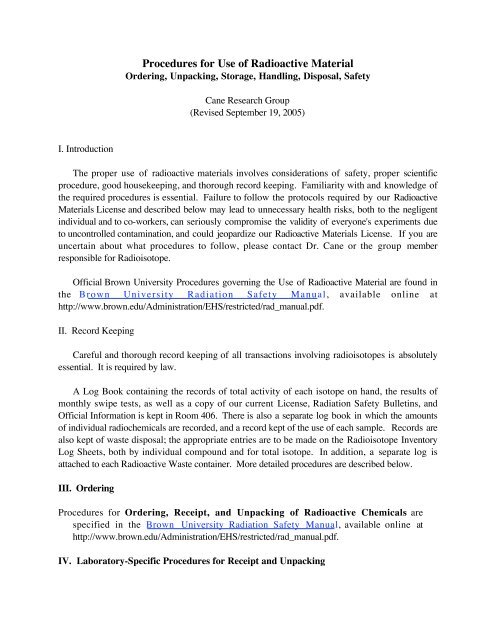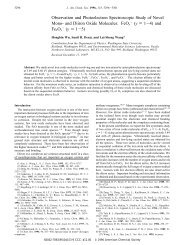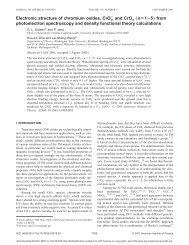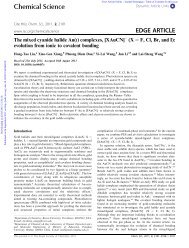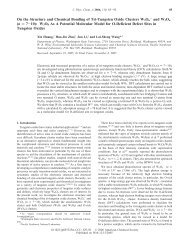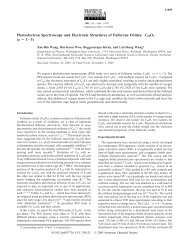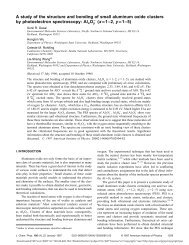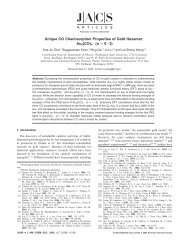Procedures for Use of Radioactive Material - Chemistry Department ...
Procedures for Use of Radioactive Material - Chemistry Department ...
Procedures for Use of Radioactive Material - Chemistry Department ...
You also want an ePaper? Increase the reach of your titles
YUMPU automatically turns print PDFs into web optimized ePapers that Google loves.
<strong>Procedures</strong> <strong>for</strong> <strong>Use</strong> <strong>of</strong> <strong>Radioactive</strong> <strong>Material</strong><br />
Ordering, Unpacking, Storage, Handling, Disposal, Safety<br />
Cane Research Group<br />
(Revised September 19, 2005)<br />
I. Introduction<br />
The proper use <strong>of</strong> radioactive materials involves considerations <strong>of</strong> safety, proper scientific<br />
procedure, good housekeeping, and thorough record keeping. Familiarity with and knowledge <strong>of</strong><br />
the required procedures is essential. Failure to follow the protocols required by our <strong>Radioactive</strong><br />
<strong>Material</strong>s License and described below may lead to unnecessary health risks, both to the negligent<br />
individual and to co-workers, can seriously compromise the validity <strong>of</strong> everyone's experiments due<br />
to uncontrolled contamination, and could jeopardize our <strong>Radioactive</strong> <strong>Material</strong>s License. If you are<br />
uncertain about what procedures to follow, please contact Dr. Cane or the group member<br />
responsible <strong>for</strong> Radioisotope.<br />
Official Brown University <strong>Procedures</strong> governing the <strong>Use</strong> <strong>of</strong> <strong>Radioactive</strong> <strong>Material</strong> are found in<br />
the Brown University Radiation Safety Manual, available online at<br />
http://www.brown.edu/Administration/EHS/restricted/rad_manual.pdf.<br />
II. Record Keeping<br />
Careful and thorough record keeping <strong>of</strong> all transactions involving radioisotopes is absolutely<br />
essential. It is required by law.<br />
A Log Book containing the records <strong>of</strong> total activity <strong>of</strong> each isotope on hand, the results <strong>of</strong><br />
monthly swipe tests, as well as a copy <strong>of</strong> our current License, Radiation Safety Bulletins, and<br />
Official In<strong>for</strong>mation is kept in Room 406. There is also a separate log book in which the amounts<br />
<strong>of</strong> individual radiochemicals are recorded, and a record kept <strong>of</strong> the use <strong>of</strong> each sample. Records are<br />
also kept <strong>of</strong> waste disposal; the appropriate entries are to be made on the Radioisotope Inventory<br />
Log Sheets, both by individual compound and <strong>for</strong> total isotope. In addition, a separate log is<br />
attached to each <strong>Radioactive</strong> Waste container. More detailed procedures are described below.<br />
III. Ordering<br />
<strong>Procedures</strong> <strong>for</strong> Ordering, Receipt, and Unpacking <strong>of</strong> <strong>Radioactive</strong> Chemicals are<br />
specified in the Brown University Radiation Safety Manual, available online at<br />
http://www.brown.edu/Administration/EHS/restricted/rad_manual.pdf.<br />
IV. Laboratory-Specific <strong>Procedures</strong> <strong>for</strong> Receipt and Unpacking
1. All orders will be delivered unopened to the <strong>Chemistry</strong> <strong>Department</strong> Stockroom. You will be<br />
notified upon receipt.<br />
2. All packages must be examined and opened in the fume-hood in Room 406.<br />
3. Protective gloves must be used.<br />
4. Ensure that you are familiar with the proper method <strong>for</strong> opening the container (eg. glass<br />
ampoule).<br />
5. Check <strong>for</strong> cracks, or any other damage, to the container and <strong>for</strong> leakage <strong>of</strong> material.<br />
6. Even though no visible evidence <strong>of</strong> a leak exists, take great care when handling the container.<br />
7. For 3 H, 14 C, 32 P, or 35 S-labeled samples, wipe tests must be taken from the outside <strong>of</strong> the<br />
container and the results recorded in the log book.<br />
8. For packages containing 10 mCi <strong>of</strong> 3 H, 1 4 C, 32 P or 35 S (“Type-A Quantities” – see Table<br />
5, Radiation Safety Manual), a Geiger counter should be used to measure the level <strong>of</strong><br />
radiation at the surface <strong>of</strong> the package; this measurement should agree with that on the<br />
packing list. Once the package has been opened, the radiation field <strong>of</strong> the unshielded<br />
container should be measured at the surface and at 3 feet and the values recorded on the<br />
packing slip and in the log book.<br />
9. In the event <strong>of</strong> possible leakage or <strong>of</strong> any irregularity, contact Dr. Cane. Should<br />
contamination be detected on the outside <strong>of</strong> the container, notify the Radiation Safety<br />
Office.<br />
9. Remember that the material may also present a chemical hazard as well as a radiation hazard,<br />
so take appropriate precautions.<br />
10. Immediately after carrying out the above procedures, the receipt <strong>of</strong> the radiochemical must<br />
be recorded in 2 places:<br />
a) The total quantity <strong>of</strong> isotope received must be logged in on the Radioisotope Inventory<br />
Log Sheet and added to the total <strong>of</strong> isotope already on hand.<br />
b) New Radioisotope Inventory Log sheets must be added to the Radiochemical Log Book.<br />
The first sheet is the specification slip which accompanies each order and which<br />
describes the chemical, isotope, specific and total activity, and manufacturer's lot<br />
number. A second sheet should record the total isotope contained in the sample, the<br />
date received, and any relevant storage in<strong>for</strong>mation. (For example, some samples may<br />
be dissolved in 5.0 mL <strong>of</strong> water and transferred to a plastic bottle. Subsequent<br />
2
V. Storage<br />
dispensing <strong>of</strong> portions <strong>of</strong> this material will be facilitated if a record is entered <strong>for</strong><br />
activity/mL.)<br />
1. Tritum, carbon-14, and sulfur-35 labeled materials are stored in the refrigerator in Room<br />
406. Commerical samples are normally stored in the freezer section. For security, the<br />
refrigerator must be left locked. After storing or removing labeled compounds be<br />
sure to relock the refrigerator.<br />
Samples labeled with 32 P, an energetic β-emitter, must be stored in an acrylic block.<br />
container is to remain in the locked freezer in Rm 406 when not in use.<br />
This<br />
2. All samples must be properly labeled. Commercial samples must specify the radiochemical,<br />
isotope, activity, and date received. Individual synthetic samples must bear the identity <strong>of</strong> the<br />
owner as well. Remember, condensation can wash away improperly prepared labels. Do not<br />
put anything in the refrigerator thinking you will remember tomorrow what it is. You<br />
probably will not, and neither will anyone else.<br />
3. All samples must be in double containers to guard against contamination <strong>of</strong> the refrigerator<br />
and other samples due to leakage, breakage, spillage, etc. Special procedure: <strong>Use</strong> a triple<br />
bag to store samples <strong>of</strong> tritiated NaBH 4<br />
(sodium borohydride) and tritiated water.<br />
4. Each time you make a withdrawal from the stock <strong>of</strong> a commericial radiochemical, the<br />
transaction should be recorded in the Radiochemical Log Book. As stocks <strong>of</strong><br />
radiochemicals are consumed or disposed <strong>of</strong> in other ways, the appropriate subtractions<br />
should be made in the Total Activity Log.<br />
5. Special procedures are to be followed in handling and storage <strong>of</strong> tritiated water. Special<br />
precautions are taken <strong>for</strong> individuals handling more than 10 millicuries <strong>of</strong> tritiated water at<br />
one time. Skin surfaces will be monitored by swabs which will be monitored by liquid<br />
scintillation, and urine samples will be decolorized and counted by liquid scintillation. The<br />
results <strong>of</strong> personal bioassays, both positive and negative must be entered into the Bioassay<br />
Log. Bioassays should be carried out under the following conditions:<br />
1. Bioassays will be carried out whenever tritiated water is used in quantities greater than or<br />
equal to 10 mCi.<br />
2. Bioassays will be carried out whenever involatile tritiated substances or sodium<br />
[ 3 H]borohydride is used in quantities greater than or equal to 100 mCi. (N.B. special<br />
authorizaton would first have to be obtained from the Radiation Safety Office to acquire<br />
quantities <strong>of</strong> tritiated compounds in excess <strong>of</strong> our authorized laboratory limit <strong>for</strong><br />
hydrogen-3 (tritium) <strong>of</strong> 50 mCi.)<br />
3
Following the use <strong>of</strong> 10 millicuries or greater amounts <strong>of</strong> tritiated water, or 100 millicuries <strong>of</strong><br />
organic compounds, the action level is considered to be five times the normal urinary<br />
radioactivity level in the liquid scintillation assay. In cases <strong>of</strong> positive results the individual<br />
will cease working with radioactive substances, and the Radiation Safety Office will be<br />
immediately notified <strong>for</strong> guidance and further action.<br />
N.B. Tritiated water is volatile, it is normally highly active, it is readily inhaled, and it can<br />
contaminate everything in the lab if not handled sensibly. If you are careless with a sample<br />
containing 10 12 dpm, it will be a long time be<strong>for</strong>e anybody else will be able to work with samples<br />
containing 10 2 dpm.<br />
VI. Handling<br />
1. Radiochemicals are radioactive chemicals. All precautions appropriate to their chemical<br />
properties should be observed.<br />
2. Pipetting by mouth is <strong>for</strong>bidden.<br />
3. Handling or transfer <strong>of</strong> radioactive materials will be per<strong>for</strong>med in trays lined with absorbent<br />
paper and covered with aluminum foil. At the end <strong>of</strong> each series <strong>of</strong> experiments you are<br />
responsible <strong>for</strong> disposing <strong>of</strong> the liners and replacing them with fresh material. The absence<br />
<strong>of</strong> contamination should be verified by a simple swipe test.<br />
4. For each experiment carried out in Room 406, you must attach a notice with your<br />
name, the date, and the isotope(s) being used. All glassware should be<br />
decontaminated and put away within 24 h <strong>of</strong> the completion <strong>of</strong> work. In no case<br />
should dirty glassware be allowed to accumulate in the Isotope Lab.<br />
5. The rotary evaporator in Room 406 must be used with your own splash guard. This simple<br />
precaution will keep the evaporator itself uncontaminated and prevent cross-contamination<br />
by someone else's samples.<br />
5. In general, active samples or contaminated materials are to be confined to Room 406. Within<br />
Room 406, work with substantial activities should be confined, as much as possible, to the<br />
bench area between sink and hood and to the hood. The other work spaces in the room<br />
should be reserved <strong>for</strong> inactive materials, decontaminated glassware, etc. or minimal activity<br />
samples. Particular care should be taken in the vicinity <strong>of</strong> the Cahn Microbalance.<br />
6. All contaminated glassware must be given final wash using an appropriate cleaning agent<br />
such as Counts-Off. The use <strong>of</strong> Chromerge is discouraged, as chromic acid baths are<br />
certainly more hazardous than any <strong>of</strong> the minor quantities <strong>of</strong> radiochemicals that you will<br />
routinely be dealing with.<br />
4
7. Samples with total activity less than 10 6 dpm should be handled in the appropriate hoods in<br />
the individual laboratories authorized by the laboratory license, CHE-03 (Rooms 403, 404,<br />
405, 407, 412, and 455). In working with weakly active samples this will avoid<br />
contamination by other materials in Room 406. In working with radioactive materials<br />
outside <strong>of</strong> Room 406, all normal safety, containment, and handling procedures mustld be<br />
followed. All reactions and chemical manipulations should be conducted in a hood, in<br />
accord with ordinary chemical safety and containment procedures. In addition a removable<br />
'CAUTION - RADIOACTIVE MATERIAL' notice must be posted at the worksite (on the<br />
hood panel) listing the isotope being used and the person carrying out the experiment. All<br />
temporary use areas should be monitored by swipe tests at appropriate intervals and the<br />
absence <strong>of</strong> contamination verified upon completion <strong>of</strong> the experimental sequence. The<br />
results <strong>of</strong> these assays, including (and especially) negative results, must be recorded in the<br />
Log Book <strong>of</strong> Swipe Tests.<br />
8. When working with 32 P-labeled samples, use appropriate shielding, such as a plexiglass or<br />
acrylic shield. A Geiger counter must be used to monitor the radiation level in the vicinity<br />
<strong>of</strong> the experiment, be<strong>for</strong>e, during, and after each experiment and the results should be<br />
recorded.<br />
VII. Disposal<br />
Guidelines <strong>for</strong> the disposal <strong>of</strong> radioactive waste can be found in the Waste Management<br />
Instructions on the Radiation Safety web site<br />
1. Contaminated (radioactive) solid wastes, including contaminated glassware, paper towels,<br />
liners, aluminum foil, and empty scintillation vials, are to be discarded in the <strong>Radioactive</strong><br />
Waste containers according to existing regulations and the maximum activity involved<br />
entered on the log sheet attached to the container. Uncontaminated solid waste, i.e. carrying<br />
no radioactivity above background - glassware, paper towels, liners, aluminum foil, empty<br />
scintillation vials, etc - can be disposed <strong>of</strong> as ordinary trash in closed plastic garbage bags.<br />
2. Chromatographic materials and radioactive solid chemical wastes must also be disposed <strong>of</strong><br />
in the waste containers provided by the Radiation Safety Office. Special care should be<br />
taken to avoid spreading contaminated silica gel around the lab both during and after<br />
disposal. (Wrapping in aluminum foil is helpful.)<br />
3. Liquid waste samples are treated as radioactive waste:<br />
a) Tritiated water waste must be absorbed on an appropriate absorbent, capable <strong>of</strong> absorbing<br />
at least twice the quantity <strong>of</strong> liquid used (see Radiation Safety Manual 13.5) and the sealed<br />
and labeled containers placed in the <strong>Radioactive</strong> Waste container provided <strong>for</strong> this purpose.<br />
This is the preferred method <strong>for</strong> samples <strong>of</strong> tritiated water in excess <strong>of</strong> 50 mCi. For the<br />
latter type <strong>of</strong> samples, use <strong>of</strong> a double container, containing absorbent, is recommended.<br />
Under no circumstances should vials containing any liquid be placed directly in the<br />
5
adioactive solid waste barrels.<br />
b) Aqueous Liquid (<strong>for</strong> example, culture media, rinse water, and other low level waste that<br />
does not contain hazardous chemicals) can be sewer-disposed in concentrations below the<br />
limits specified in Section 15 <strong>of</strong> the Radiation Safety Manual. See the Waste Management<br />
Instructions on the Radiation Safety web site <strong>for</strong> detailed specifications. All sink disposals<br />
must be recorded. R. I. Law <strong>for</strong>bids disposal <strong>of</strong> any hazardous chemical waste down the<br />
sinks.<br />
4. Liquid scintillation cocktails and vials.<br />
a) Liquid scintillation cocktail (Optifluor) containing no measurable activity above<br />
background can be disposed <strong>of</strong> as ordinary chemical waste in the appropriate laboratory<br />
waste containers.<br />
b) For liquid scintillation vials containing measurable activity less than 0.05 µCi/mL (10 5<br />
dpm/mL): Do not pour the liquid from the liquid scintillation vials. Cap them tight and put<br />
them in the designated white pails with thick plastic liners. Keep a record <strong>of</strong> the activity in<br />
the bucket on the <strong>for</strong>m RSO-15 as well as the identity <strong>of</strong> the cocktail used. These buckets<br />
will be collected by the Radiation Safety Office <strong>for</strong> proper disposal.<br />
c) For liquid scintillation vials containing greater than 0.05 µCi/mL (10 5 dpm/mL): This<br />
situation would be highly unusual since the levels <strong>of</strong> activity would exceed the normal<br />
counting range <strong>of</strong> the liquid scintillation spectometer. Should such vials exist, do not pour<br />
the contents out. Place the vial in a separate bucket with appropriate labeling <strong>for</strong> disposal by<br />
the Radiation Safety Office.<br />
5. Ultima-flo scintillation cocktail is used with the HPLC scintillation counter. The HPLC<br />
system has a cut <strong>of</strong>f which is set to divert cocktail with more than 888 cpm to a radioactive<br />
waste container. This container should be properly labeled on the <strong>for</strong>m RSO-15, indicating<br />
the identity and total volume <strong>of</strong> HPLC solvent and the total radioactivity in the container.<br />
When full, this container should be properly sealed and turned over to the Radiation Safety<br />
Office <strong>for</strong> proper disposal. Given the scale <strong>of</strong> most laboratory experiments it is highly<br />
unlikely that the final concentration will exceed 0.05 µCi/mL (10 5 dpm/mL).<br />
The remaining HPLC effluent is disposed <strong>of</strong> as normal hazardous chemical waste.<br />
6. Storage <strong>of</strong> waste containing 32 P (half-life 14.3 d) or 35 S (half-life ca. 88 d) until it has<br />
decayed to low levels (10 half-lives) is recommended, provided that the waste is properly<br />
shielded. Small volumes <strong>of</strong> 32 P can be stored in an acrylic box behind an acrylic shield in<br />
the hood in Room 406. Sulfur-35 waste is to be stored in labeled plastic bags or bottle<br />
under the radiation safety hood in Room 406. Any stored waste must be labeled to indicate<br />
the isotope, amount at time <strong>of</strong> storage, date <strong>of</strong> storage and your name. Alternatively, the<br />
Radiation Safety Office has space available <strong>for</strong> this purpose. Stored 32 P and 35 S waste<br />
must be checked with a Geiger Counter to verify that it is inactive be<strong>for</strong>e final disposal.<br />
VIII. General Safety<br />
6
1. Eating, drinking, smoking and the use <strong>of</strong> cosmetics in the laboratory are not permitted.<br />
2. Be<strong>for</strong>e a worker leaves the laboratory the hands must be washed.<br />
3. If, in the course <strong>of</strong> work, personal contamination is suspected, this should be reported to Dr.<br />
Cane immediately.<br />
4. Gloves should be worn at all times when working with radioactive materials.<br />
5. In the event <strong>of</strong> a spillage, the following procedures should be adopted:<br />
a. The liquid should be blotted up (wear rubber gloves).<br />
b. All disposable materials contaminated by the spill and the cleaning process should be<br />
placed in a container <strong>for</strong> radioactive waste.<br />
c. After cleaning up, the area <strong>of</strong> the spill must be monitored by swipe test. If necessary,<br />
cleaning should be repeated until swipe tests confirm complete absence <strong>of</strong> removable<br />
activity.<br />
6. All wounds, spills, and other emergencies should be reported to Dr. Cane immediately.<br />
7. Adequate protective clothing, appropriate to the level <strong>of</strong> activity being handled, should be<br />
worn.<br />
8. The door to Room 406 should be left locked when the laboratory is not<br />
in use. The last person to leave the laboratory in the evening should<br />
check to see that the door to Room 406 is locked.<br />
IX. Swipe Tests and BioAssays<br />
1. The person responsible <strong>for</strong> the isotope lab will conduct monthly swipe tests in Room 406<br />
and see that any contamination is cleaned up. Responsibility <strong>for</strong> swipe tests in other<br />
laboratories (See Section VI.7) rests with the individual carrying out experiments in those<br />
labs. The results must be recorded on the appropriate Swipe Test record sheet. In all cases,<br />
you are personally responsible <strong>for</strong> good housekeeping, including cleaning up after yourself.<br />
2. To per<strong>for</strong>m a swipe test, moisten a Kimwipe with water), wipe the area to be monitored (ca. 4<br />
x 4 in; wear gloves) and put the Kimwipe in a scintillation vial containing 10 mL <strong>of</strong><br />
scintillation cocktail. Close the vial, shake gently, and count. Swipe tests must be counted<br />
in duplicate to eliminate false readings that might result from chemiluminsecence . In the<br />
event that contamination above background is observed, the area should be cleaned and the<br />
7
swipe test repeated until the affected area has been satisfactorily decontaminated. All swipe<br />
tests should also include the counting <strong>of</strong> a standard.<br />
3. When working with 32 P, monitor yourself and your work area with a Geiger counter. The<br />
monitoring results must be recorded with the date each time 32 P is used. Be<strong>for</strong>e initiating<br />
work with 32 P, you must obtain an Exposure Monitoring Badge (Thermo Luminescent<br />
Devices) (both finger and body badges) from the Radiation Safety Office. These badges<br />
should be turned in to the Radiation Safety Office at the end <strong>of</strong> each quarter. In the event<br />
that you think you have been exposed to excess radiation, the badges should be turned in<br />
immediately.<br />
4. When working with greater than 10 mCi <strong>of</strong> tritiated water or 100 mCi <strong>of</strong> other tritiated<br />
material, urine bioassays should be per<strong>for</strong>med as described in Section V.5. above.<br />
8


